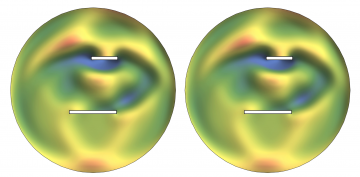
Achievement
This paper presents a new approach for constructing accurate absorbing boundary conditions for (nonlocal) peridynamic scalar wave-type problems in viscous media.
Significance and Impact
Artificial boundary methods are commonly employed to solve problems on unbounded domains, and the perfectly matched layer (PML) and the absorbing boundary conditions (ABCs) are the most prominent such methods. However, in the context of nonlocal models, these methods present important challenges. The PML method results in grid-dependent performance and numerical instability of discrete systems. On the other hand, implementation of ABCs often results in substantial demands of computational resources; frequently involves complicated Fourier and Laplace transforms procedures due to nonlocality; and, in the case of high-order ABCs, requires auxiliary variables on the truncating boundary. The proposed approach to construct ABCs, in contrast, is easy to implement since the ABCs are of Dirichlet type and thus can simply be imposed as nodal values; it is free of any Fourier or Laplace transforms and is developed directly in the time and space domains; it does not require introduction of auxiliary variables; and it is consistent with the numerical dispersion relation of the near-field solution.
Research Details
This paper introduces a new approach to tackle the construction of absorbing boundary conditions (ABCs) for the (nonlocal) peridynamic (PD) scalar wave-type equation in unbounded viscous media. The proposed ABCs are of Dirichlet type, which facilitates their application since their implementation neither depends on differentiation procedures nor uses auxiliary variables which are not straightforward to incorporate even for the case of the classical (local) scalar wave equation. The ABCs are derived from a semi-analytical solution of the exterior domain (far field) consisting of plane-wave modes. In this way, the modes satisfy the nonlocal dispersion relation corresponding to the PD scalar wave-type equation and converge to the modes corresponding to the local equation in the limit of vanishing nonlocality. The ABCs are entirely developed in the time and space domains without the utilization of Fourier or Laplace transforms, which proves to be complex for nonlocal models. Our numerical studies show that, at the discrete level, the far-field solution is obtained consistent with that of the near field, in terms of the dispersion relation, provided that the modes are calculated using the same numerical dispersion relation of the near field. The unknown coefficients of the far-field semi-analytical solution are calculated through a simple collocation procedure in space and time. A comprehensive discussion on efficient derivation of the unknown coefficients is presented. The performance of the proposed ABCs in terms of accuracy and stability is shown through several numerical examples in 2D. Our investigation demonstrates that the proposed ABCs yield a proper level of accuracy even in problems characterized by highly-dispersive propagating waves.
Overview
Construction of absorbing boundary conditions (ABCs) for nonlocal models is generally challenging, primarily due to the fact that nonlocal operators are commonly associated with volume constrained boundary conditions. Moreover, application of Fourier and Laplace transforms, which are essential for the majority of available methods for ABCs, to nonlocal models is complicated. In this paper, we propose a simple method to construct accurate ABCs for peridynamic scalar wave-type problems in viscous media. The proposed ABCs are constructed in the time and space domains and are of Dirichlet type. Consequently, their implementation is relatively simple, since no derivatives of the wave field are required. The proposed ABCs are derived at the continuum level, from a semi-analytical solution of the exterior domain using harmonic exponential basis functions in space and time (plane-wave modes). The numerical implementation is done using a meshfree collocation approach employed within a boundary layer adjacent to the interior domain boundary. The modes satisfy the peridynamic numerical dispersion relation, resulting in a compatible solution of the interior region (near field) with that of the exterior region (far field). The accuracy and stability of the proposed ABCs are demonstrated with several numerical examples in two-dimensional unbounded domains.
To view the publication click here.
Last Updated: May 17, 2023 - 10:07 am